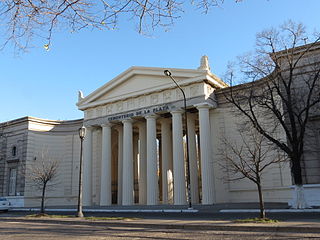These lists of cemeteries compile notable cemeteries, mausolea, and other places people are buried worldwide. Reasons for notability include their design, their history, and their interments.

La Recoleta Cemetery is a cemetery located in the Recoleta neighbourhood of Buenos Aires, Argentina. It contains the graves of notable people, including Eva Perón, presidents of Argentina, Nobel Prize winners, the founder of the Argentine Navy, and military commanders such as Julio Argentino Roca. In 2011, the BBC hailed it as one of the world's best cemeteries, and in 2013, CNN listed it among the 10 most beautiful cemeteries in the world.

Asociación Mutual Israelita Argentina is a Jewish Community Centre located in Buenos Aires, Argentina.

The history of the Jews in Argentina goes back to the early sixteenth century, following the expulsion of Jews from Spain. Sephardic Jews fleeing persecution immigrated with explorers and colonists to settle in what is now Argentina, in spite of being forbidden from travelling to the American colonies. In addition, many of the Portuguese traders in the Viceroyalty of the Río de la Plata were Jewish. An organized Jewish community, however, did not develop until after Argentina gained independence from Spain in 1816. By mid-century, Jews from France and other parts of Western Europe, fleeing the social and economic disruptions of revolutions, began to settle in Argentina. Argentines of both Ashkenazi and Sephardic heritage have left their mark on all aspects of Argentine culture, including in areas such as cuisine.

The history of the Jews in Mexico began in 1519 with the arrival of Conversos, often called Marranos or "Crypto-Jews", referring to those Jews forcibly converted to Catholicism and that then became subject to the Spanish Inquisition.

The Jewish Cemetery of Coro is the oldest Jewish cemetery in continuous use in the Americas.
La Paz is a small city in the Canelones Department, southern Uruguay.

The history of the Jews in Bolivia goes back to the colonial period of Bolivia in the 16th century. In the 19th century, Jewish merchants came to Bolivia, most of them taking local women as wives and founding families that merged into the mainstream Catholic society. This was often the case in the eastern regions of Santa Cruz, Tarija, Beni and Pando, where these merchants came either from Brazil or Argentina.

The history of the Jews in Uruguay dates back to the colonial empire. The most important influx of Jewish population occurred during the end of the 19th century and the first half of the 20th century, mainly during World War II.

The history of the Jews in Peru dates back to the country's Spanish period with the arrival of migration flows of Sephardic Jews from Europe, the Near East and Northern Africa. This small community virtually disappeared as a result of the Inquisition, and a second migratory wave revived it only during the mid-20th century due to World War II, with a number of Ashkenazi Jews arriving to the country's capital, Lima, through neighbouring Callao, where they also settled. In addition to the aformentioned groups, a separate community known as the Amazonian Jews have resided in and around the northern city of Iquitos since the late 19th century.
Ricardo Udler Cymerman is a Bolivian gynaecologist. He currently serves as Chairman of the Israelite Club of Bolivia and acts as leader of the Jewish community of Bolivia in general.
The Fraternity Award is an honor given annually by the Uruguayan branch of the Jewish organization B'nai B'rith.

The Comité Central Israelita del Uruguay is the umbrella and central organization of Uruguay's Jewish community. Established in 1940 it gathers 29 Jewish Zionist institutions, serving as the community's political representative in official events and conducts all contact with authorities.

The Cemetery of San Fernando is located in the San Jerónimo district, north of the city of Seville, Andalusia, Spain. It was built in 1852, and it is the only municipal cemetery in the city. It has an area of 28 hectares and is considered as one of the most famous cemeteries in Spain.

Andrés Abt was a Uruguayan politician who served as a member in the Chamber of Representatives and as mayor of Montevideo's CH Municipality.

The Movimiento Judío por los Derechos Humanos was a human rights organization in Argentina. It was founded by Marshall Meyer and Herman Schiller on August 19, 1983.

The Cemetery of La Plata is one of the most important cemeteries in Buenos Aires Province, Argentina. It is located on the intersection of Avenue 31, 72 and diagonal 74 in Altos de San Lorenzo, La Plata. It was declared a Cultural Heritage and Memorial of Buenos Aires Province.
Alberto Sonsol Cohen was a Uruguayan sports journalist, sportscaster and television presenter.

The La Tablada Israelite Cemetery, also known simply as the La Tablada Cemetery, is a Jewish cemetery located in the city of La Tablada, in the Greater Buenos Aires conurbation of Argentina. It was established in 1936 and is operated by the Asociación Mutual Israelita Argentina (AMIA).














